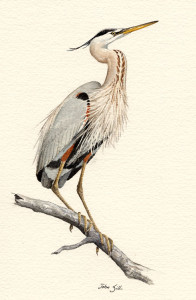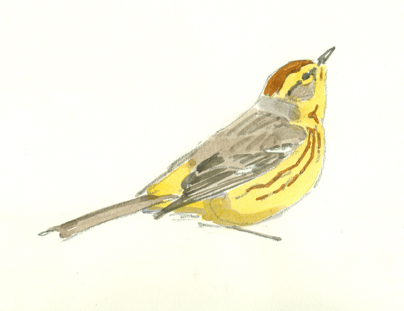“The heron stands in water where the swamp
Has deepened to the blackness of a pool,
Or balances with one leg on a hump
Or marsh grass heaped above a muskrat hole.”
Theodore Roethke, “The Heron”
Barry just posted about a wonderful day he spent sketching and observing great blue herons at the Rocky Hill Wildlife Sanctuary in Groton, Massachusetts. Although they were once quite rare in the Eastern United States due to pollution and over hunting, great blue heron populations have rebounded and are now a common sight in Massachusetts.
Great blue herons are the largest and most widely distributed heron in Massachusetts and Eastern US. Great blue herons are wading birds in the order Pelicaniformes and in the family Ardeidae, which consists of bitterns, herons, and egrets in the United States.
Nesting: Herons nest in rookeries, specifically in the tops of tall dead trees located in swampy habitat, which Barry captured in his watercolors. In Massachusetts, many rookeries are the result beaver dams that have flooded areas, creating swamps or small ponds, killing trees. Nests are made out of sticks that form platforms and are lined with leaves, moss, pine needles, and other leaf material. Check out the video below to learn more.
Feeding: Herons are one of the top predators in many aquatic ecosystems and play an extremely important role in the aquatic food web. Their diet consists primarily of fish, using their spear-like beak to pierce their prey and swallow it whole. In addition, herons will also hunt for frogs, salamanders, snakes, rodents, other small mammals, crustaceans like crabs, small birds, and other small animals.
Population declines in the 19th and 20th century: Their status as a top predator also made them extremely susceptible to widespread pollution and played a large role in their dramatic population declines in the early and mid 20th century. Because herons eat other aquatic predators, which eat plants rich with toxins, including by-products of now banned DDT and PCBS, herons would ingest large quantities of pollutants which had dramatic negative effects on their reproduction. This process is called bio-accumulation.
Natural History Tidbits from Recent Research:
- The natural world is full of surprises!
In the Pacific Northwest, great blue herons have become more likely to nest in bald eagle territories. This seems extremely odd because bald eagles are extremely territorial and have been observed to attack herons and other birds that are present in their territory. However, Jones et al. (2013) has shown that herons that build nests within eagle territories have higher reproductive success because the eagles keep out potential predators that would eat heron chicks. Talk about free security. - Are herons aquatic gardeners? Yes…but indirectly.
Herons can change the types of plants and animals present in a sea grass ecosystem. Herons eat lots of fish, especially in the spring and early summer. When herons eat lots of fish, there are less fish present to eat other aquatic invertebrates, which eat the sea grass, these little critters are called amphipods. More herons, less fish, more amphipods, less sea grass. When herons were excluded from the aquatic system, more fish are present and they eat lots of aquatic invertebrates, specifically really important invertebrates call amphipods, and the entire system changes to a shrimp dominated system and the plant community changes. Learn more about this study by Huang et al. (2015). - Wow! Herons were recently observed to eat stringrays…the picture speaks for itself. Find out more about herons eating stingrays.
A few delightful comments on the great blue heron from the late 19th century:
How do great blue herons do in a Massachusetts winter:
“In such an event they (great blue heron) might survive the following winter if it should prove to be a mild one, while the stoutest heart among them would probably succumb to the rigors of a genuine ‘old-fashioned’ New England winter.” Walter Faxon, MCZ, Cambridge, Massachusetts
“The Great Blue Heron (Ardea herodias) is a bird that rarely favors us with his presence in the winter months. It may be worth while, then, to chronicle the capture of one in the Arnold Arboretum, West Roxbury, Mass., either December 31, 1889, or January 1, 1890. A tub of water stocked with minnows served to keep him alive for five or six days, when he suddenly died either from cold or the enervating effects of imprisonment.” Walter Faxon, MCZ, Cambridge, Massachusetts
Source: The Long-Billed Marsh Wren, Maryland Yellow-Throat, Nashville Warbler and Great Blue Heron in Eastern Massachusetts in Winter Author(s): Walter Faxon, The Auk, Vol. 7, No. 4 (Oct., 1890), pp. 408-410
To Learn More:




